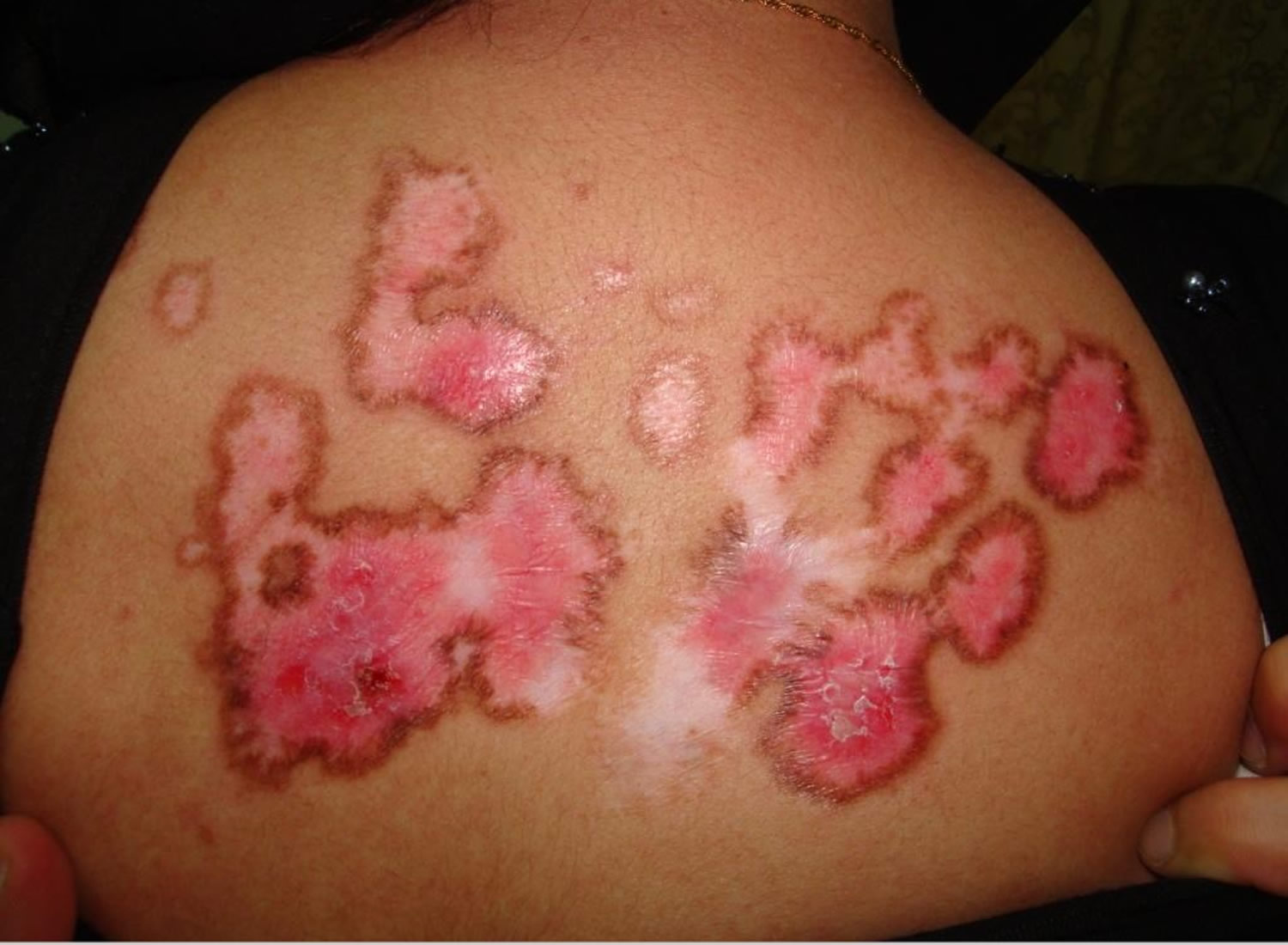Contents
What is lupus
Lupus also known as systemic lupus erythematosus (SLE), is a chronic (long-term) inflammatory disease that can affect almost any part of your body, especially the skin, joints, kidneys, heart, lungs, bones, blood, or brain. Systemic lupus erythematosus is considered an autoimmune disorder, meaning that a person’s own immune system attacks his or her own healthy cells and tissues, causing inflammation and damage 1.
Because systemic lupus erythematosus can affect any organ system, no two people have identical forms of the disease. However, most people with systemic lupus erythematosus report periods of time in which their symptoms seem to be mild or absent (remission) and other periods of time when the inflammation is more severe (flare or relapse).
In addition to affecting the skin and joints, it can affect other organs in the body such as the kidneys, the tissue lining the lungs (pleura), heart (pericardium), and brain. Many patients experience fatigue, weight loss, and fever.
- Lupus occurs ten times more often in women than in men.
- Treatment depends on the organs involved .
- Involvement of the kidneys or/and the brain is the most serious manifestation of lupus.
- People can live well with lupus if they actively work toward good health.
- Sun exposure can lead to lupus flares.
- Carefully plan your pregnancies; lupus can flare during pregnancy and can affect its outcome.
Lupus flares vary from mild to serious. Most patients have times when the disease is active, followed by times when the disease is mostly quiet – referred to as a remission. Yet, there is much reason for hope. Improvements in treatment have greatly improved these patients’ quality of life and increased their lifespan.
See your doctor if you:
- develop an unexplained skin rashes – often over the nose and cheeks
- ongoing fever,
- persistent aching or fatigue,
- joint pain and stiffness,
- extreme tiredness that won’t go away no matter how much you rest
As well as the main symptoms, you might also have:
- weight loss
- swollen glands
- sensitivity to light (causing rashes on uncovered skin)
- poor circulation in fingers and toes (Raynaud’s)
Lupus disease in women
If you are a young woman with lupus and wish to have a baby, carefully plan your pregnancy. With your doctor’s guidance, time your pregnancy for when your lupus activity is low. While pregnant, avoid medications that can harm your baby. These include cyclophosphamide, cyclosporine, and mycophenolate mofetil. If you must take any of these medicines, or your disease is very active, use birth control.
The relationship between lupus activity and pregnancy is more debated. In general, there is a tendency for mild to moderate flares, especially during the second half of pregnancy and the post-partum period. However, most of these flares do not endanger the mother’s or the baby’s life, nor do they substantially alter the long-term prognosis of lupus. Being in clinical remission for three – six months prior to getting pregnant decreases the chance that a flare will occur during the pregnancy.
Patients who have or have had kidney disease, due to lupus, generally have an increased risk of severe hypertension and pre-eclampsia. If kidney function and blood pressure prior to pregnancy are normal and the disease is inactive at the time of conception for a period of at least six months, the outcome is likely to be good. Women with severely impaired kidney function, uncontrolled hypertension (high blood pressure), and/or active lupus disease flares are advised not to get pregnant.
Facts
- Each woman’s lupus disease should be well under control for a period of at least three – six months before attempting pregnancy. As long as your medicines are not harmful to the fetus, you should remain on your medicines to prevent risk of a disease flare. Any changes should be discussed in advance with your rheumatologist.
- Women with a low-risk profile can be managed with usual visits to the rheumatologist as a precaution. Those with a high-risk profile should be managed by both the rheumatologist and obstetric team with experience in high-risk pregnancies
Rheumatologists have long been concerned that the female hormone estrogen or treatment with estrogen may cause or worsen lupus. Recent research showed that estrogen therapy can trigger some mild or moderate flares of lupus, but does not cause symptoms to get much worse. Yet, estrogen can raise the risk of blood clots. Thus, you should not take estrogen if your blood tests show antiphospholipid antibodies (meaning you already have a high risk of blood clots).
Management of pregnancy in women with lupus disease
All women with lupus disease should undergo counseling about their specific risks if they are thinking about having a baby. During that discussion with your doctor, you can review specific concerns of pregnancy and learn what pregnancy complications can occur.
Here are a few things that make a pregnancy “high risk.”
- Previous pregnancy with complications
- Underlying kidney disease
- Underlying heart disease
- Underlying lung disease (including pulmonary hypertension)
- Flare of a lupus disease
- A history of previous blood clot
- Presence of anti-Ro (SSA) and anti-La (SSB) antibodies
- IVF (in vitro fertilization)
- Pregnancy with twins, triplets, etc.
- Mother being over 40
Each woman’s lupus disease should be well under control for a period of at least three – six months before attempting pregnancy. As long as your medicines are not harmful to the fetus, you should remain on your medicines to prevent risk of a disease flare. Prednisone should be used at doses below 10mg/day whenever possible, due to the risk of associated complications such as high blood pressure, diabetes, excessive weight gain, risk of infections, and premature rupture of membranes. Hydroxychloroquine is an extremely safe drug for both the mother and the fetus and should not be stopped before, during, or after pregnancy. High blood pressure should be managed using medicines that are safe during pregnancy. Captopril and enalapril are safe drugs during breastfeeding.
Women with a low-risk profile should include in their usual treatment plan regular three-month visits to the rheumatologist, as a precaution. However, those with a high-risk profile should be managed by a combined medical and obstetric team with experience in high-risk pregnancies. Visits should be more frequent as pregnancy advances (weekly during the late third trimester), and include monitoring of fetal and maternal well-being. Blood pressure measurements and urine testing should be frequently performed to assure the early detection and treatment of pre-eclampsia.
Use of rheumatic medications during pregnancy and lactation
During pregnancy, the effects of inflammation when lupus disease becomes active and medications used to treat rheumatic disease can cause problems. Information on the safety of many drugs in pregnant women is incomplete and difficult to obtain. Based on the information available, most rheumatologists generally recommend the following:
Table 1: Acceptable medications during pregnancy and lactation
| Pregnancy | Lactation | |
|---|---|---|
| NSAID | Yes (avoid after 32 weeks) | Yes |
| Sulfasalazine | Yes | Yes |
| Antimalarials | Yes | Yes |
| Corticosteroids | Yes | Yes |
| Cyclosporine | Yes | Probably yes |
| Azathioprine | Yes | Probably yes |
| Mycophenolate | No | No |
| Methotrexate | No | No |
| Cyclophosphamide | No | No |
| Anti-tumor necrosis factor (TNF) | Yes | Yes |
| Rituximab | No | No |
| Warfarin | No (with caution, only after first trimester) | Yes |
| Heparin | Yes | Yes |
This list should only be considered a general guide and may not apply in all situations. Women who are pregnant or considering pregnancy should discuss their medications with both their rheumatologist and their obstetrician. Many women would prefer to take no medication during pregnancy and nursing. However, the consequences of not being on medicine and the risk of their rheumatic disease flaring are important considerations that should be discussed with both the rheumatologist and obstetrician.
Several drugs (particularly methotrexate and cyclophosphamide have effects on sperm cells in men. It is recommended that these medications be stopped for three months before a man fathers a child.
Figure 1. Lupus rash
Figure 2. Systemic lupus erythematosus rash on back
Figure 3. Systemic lupus erythematosus rash hand
Who’s at risk of lupus disease?
Systemic lupus erythematosus can occur in people of all ages, all races, and both sexes. However, it is far more common in women, especially those between 15–45 years old. In America, it is also more commonly seen in people with darker skin than in light-skinned people.
Although it is not directly inherited, lupus and other autoimmune diseases may run in families. Inheriting certain genes may make some people more susceptible to developing lupus.
In addition, certain environmental factors may trigger lupus in those who have a family (genetic) tendency toward the disease, including:
- Ultraviolet light, especially sunlight
- Certain medications, especially hydralazine and procainamide
- Infections
- Antibiotics, especially penicillins or sulfa-containing medicines
- Stress
- Hormonal changes, especially related to pregnancy and menstrual cycles
Complications of lupus
Lupus disease, especially when active, could lead to accelerated atherosclerosis (clogging of the arteries) which can develop in young women and could also lead to heart attacks, heart failure, and strokes. Thus, it is vital that patients with lupus, in addition to controlling their disease, exercise and lower other risk factors for heart disease, such as smoking, high blood pressure, and high cholesterol.
Renal inflammation is one of the common and most serious manifestations of lupus. It could go undetected and can lead to renal failure and dialysis. You can help prevent these serious outcomes by seeking treatment at the first signs of kidney disease. These signs include:
- High blood pressure
- Swollen feet and hands
- Puffiness around your eyes
- Changes in urination (blood or foam in the urine, going to the bathroom more often at night, or pain or trouble urinating)
Inflammation caused by lupus can affect many areas of your body, including your:
- Kidneys. Lupus can cause serious kidney damage, and kidney failure is one of the leading causes of death among people with lupus.
- Brain and central nervous system. If your brain is affected by lupus, you may experience headaches, dizziness, behavior changes, vision problems, and even strokes or seizures. Many people with lupus experience memory problems and may have difficulty expressing their thoughts.
- Blood and blood vessels. Lupus may lead to blood problems, including anemia and increased risk of bleeding or blood clotting. It can also cause inflammation of the blood vessels (vasculitis).
- Lungs. Having lupus increases your chances of developing an inflammation of the chest cavity lining (pleurisy), which can make breathing painful. Bleeding into lungs and pneumonia also are possible.
- Heart. Lupus can cause inflammation of your heart muscle, your arteries or heart membrane (pericarditis). The risk of cardiovascular disease and heart attacks increases greatly as well.
Other types of complications
Having lupus also increases your risk of:
- Infection. People with lupus are more vulnerable to infection because both the disease and its treatments can weaken the immune system.
- Cancer. Having lupus appears to increase your risk of cancer; however the risk is small.
- Bone tissue death (avascular necrosis). This occurs when the blood supply to a bone diminishes, often leading to tiny breaks in the bone and eventually to the bone’s collapse.
- Pregnancy complications. Women with lupus have an increased risk of miscarriage. Lupus increases the risk of high blood pressure during pregnancy (preeclampsia) and preterm birth. To reduce the risk of these complications, doctors often recommend delaying pregnancy until your disease has been under control for at least six months.
Lupus causes
When healthy, your immune system protects your body from foreign germs and cancers. With lupus your immune system attacks healthy tissue in your body (autoimmune disease). It’s likely that lupus results from a combination of your genetics and your environment. However, the cause of Lupus is unknown, as well as what drives its diverse presentation. Doctors know that multiple factors are required, including: the “right” genetic makeup, environmental exposures, and organ specific characteristics. People with lupus may also have an impaired process for clearing old and damaged cells from the body, which in turn provides continuous stimuli to the immune system and leads to abnormal immune response.
In lupus as the attack goes on, all the branches of the immune system join the fight. This leads to significant and intense inflammation.
Most often, lupus starts in young females in their fertility age. The disease is more common in some ethnic groups, mainly blacks and Asians, and tends to be worse in these groups.
It appears that people with an inherited predisposition for lupus may develop the disease when they come into contact with something in the environment that can trigger lupus. The cause of lupus in most cases, however, is unknown. Some potential triggers include:
- Sunlight. Exposure to the sun may bring on lupus skin lesions or trigger an internal response in susceptible people.
- Infections. Having an infection can initiate lupus or cause a relapse in some people.
- Medications. Lupus can be triggered by certain types of blood pressure medications, anti-seizure medications and antibiotics. People who have drug-induced lupus usually get better when they stop taking the medication. Rarely, symptoms may persist even after the drug is stopped.
Risk factors for lupus
Factors that may increase your risk of lupus include:
- Your sex. Lupus is more common in women.
- Age. Although lupus affects people of all ages, it’s most often diagnosed between the ages of 15 and 45.
- Race. Lupus is more common in African-Americans, Hispanics and Asian-Americans.
Lupus signs and symptoms
People with lupus often have symptoms that are not specific to lupus. These include fever, fatigue, weight loss, blood clots, and hair loss in spots or around the hairline. They may also have heartburn, stomach pain, and poor circulation to the fingers and toes. Pregnant women can have miscarriages.
However, more than 90% of people with systemic lupus erythematosus have skin symptoms. The most common locations for the skin lesions of systemic lupus erythematosus include:
- Face, especially cheeks and nose
- Sun-exposed skin on arms, backs of hands, upper chest, and upper back due to increased sensitivity to sunlight (photosensitivity)
- Fingers and fingernails
- Mouth or nose
- Scalp
The classic skin finding in systemic lupus erythematosus is the butterfly rash (malar blush). Redness across the cheeks and bridge of the nose can occur after sun exposure and may appear as much as several weeks before other symptoms develop.
A rash can develop in sun-exposed skin (photo-distribution), especially on the backs of the hands and fingers. This rash, which appears as red, scaly patches, can also affect the arms and trunk.
The skin around fingernails (nail folds) can be red and inflamed, and tiny, dilated blood vessels (telangiectasia) may be seen. In addition, people may develop Raynaud phenomenon, in which the fingers (and sometimes toes) turn pale and numb after exposure to cold temperatures.
Small, painless ulcers can develop in the nose or, more commonly, in the mouth, especially on the roof of the mouth.
When lupus affects the scalp skin, you may notice hair loss. It may be patchy, or there may be thinning across the scalp, especially at the temples.
In addition to the skin lesions of lupus, people may have:
- Joint pain or swelling, especially in hands, wrists, and knees
- Blood problems, including anemia and clotting disorders
- Kidney disorders
- Lung problems, such as painful breathing
- Seizures or other brain disorders
- Swollen lymph glands
- Fever
- Fatigue
Lupus diagnosis
Diagnosing lupus is difficult because signs and symptoms vary considerably from person to person. Signs and symptoms of lupus may vary over time and overlap with those of many other disorders. As experts in diagnosing and treating autoimmune diseases such as lupus, rheumatologists can best determine whether a patient has lupus and advise them about treatment options.
No one test can diagnose lupus. The combination of blood and urine tests, signs and symptoms, and physical examination findings leads to the diagnosis.
The American College of Rheumatology 3 has a list of symptoms and other measures that doctors can use as a guide to decide if a patient with symptoms has lupus.
Rashes:
- butterfly-shaped rash over the cheeks – referred to as malar rash
- red rash with raised round or oval patches – known as discoid rash
- rash on skin exposed to the sun
Mouth sores: sores in the mouth or nose lasting from a few days to more than a month
Arthritis: tenderness and swelling lasting for a few weeks in two or more joints
Lung or heart inflammation: swelling of the tissue lining the lungs (referred to as pleurisy or pleuritis) or the heart (pericarditis), which can cause chest pain when breathing deeply
Kidney problem: blood or protein in the urine, or tests that suggest poor kidney function
Neurologic problem: seizures, strokes, or psychosis (a mental health problem)
Abnormal blood tests such as:
- low blood cell counts: anemia, low white blood cells, or low platelets
- positive antinuclear antibodies (ANA) result: antibodies that can cause the body to begin attacking itself that are present in nearly all lupus patients
- certain abnormal antibodies: anti-double-strand DNA (called anti-dsDNA), anti-Smith (referred to as anti-Sm), or antiphospholipid antibodies
If your doctor suspects you have lupus based on your symptoms, a series of blood tests will be done in order to confirm the diagnosis. The most important blood screening test is ANA. If ANA is negative, you don’t have lupus. However, if ANA is positive, you might have lupus and will need more specific tests. These blood tests include antibodies to anti-dsDNA and anti-Sm, which are specific to the diagnosis of lupus.
The presence of antiphospholipid antibodies signals a raised risk for certain complications such as miscarriage or blood clots.Doctors also may measure levels of certain complement proteins (a part of the immune system) in the blood, to help detect the disease and follow its progress.
Laboratory tests
Blood and urine tests may include:
- Complete blood count. This test measures the number of red blood cells, white blood cells and platelets as well as the amount of hemoglobin, a protein in red blood cells. Results may indicate you have anemia, which commonly occurs in lupus. A low white blood cell or platelet count may occur in lupus as well.
- Erythrocyte sedimentation rate. This blood test determines the rate at which red blood cells settle to the bottom of a tube in an hour. A faster than normal rate may indicate a systemic disease, such as lupus. The sedimentation rate isn’t specific for any one disease. It may be elevated if you have lupus, an infection, another inflammatory condition or cancer.
- Kidney and liver assessment. Blood tests can assess how well your kidneys and liver are functioning. Lupus can affect these organs.
- Urinalysis. An examination of a sample of your urine may show an increased protein level or red blood cells in the urine, which may occur if lupus has affected your kidneys.
- Antinuclear antibody (ANA) test. A positive test for the presence of these antibodies — produced by your immune system — indicates a stimulated immune system. While most people with lupus have a positive ANA test, most people with a positive ANA do not have lupus. If you test positive for ANA, your doctor may advise more-specific antibody testing.
Imaging tests
If your doctor suspects that lupus is affecting your lungs or heart, he or she may suggest:
- Chest X-ray. An image of your chest may reveal abnormal shadows that suggest fluid or inflammation in your lungs.
- Echocardiogram. This test uses sound waves to produce real-time images of your beating heart. It can check for problems with your valves and other portions of your heart.
Biopsy
Lupus can harm your kidneys in many different ways, and treatments can vary, depending on the type of damage that occurs. In some cases, it’s necessary to test a small sample of kidney tissue to determine what the best treatment might be. The sample can be obtained with a needle or through a small incision.
Skin biopsy is sometimes performed to confirm a diagnosis of lupus affecting the skin.
Lupus treatment
Lupus is a chronic disease. The treatment objective is to induce remission. Treatment depends on the type of symptoms you have and how serious they are. Determining whether your signs and symptoms should be treated and what medications to use requires a careful discussion of the benefits and risks with your doctor.
As your signs and symptoms flare and subside, you and your doctor may find that you’ll need to change medications or dosages. The medications most commonly used to control lupus include:
- Nonsteroidal anti-inflammatory drugs (NSAIDs). Over-the-counter NSAIDs, such as naproxen sodium (Aleve) and ibuprofen (Advil, Motrin IB, others), may be used to treat pain, swelling and fever associated with lupus. Stronger NSAIDs are available by prescription. Side effects of NSAIDs include stomach bleeding, kidney problems and an increased risk of heart problems. Always check with your doctor before taking any medications that are over the counter (without a prescription) for your lupus.
- Antimalarial drugs. Medications commonly used to treat malaria, such as hydroxychloroquine (Plaquenil), affect the immune system and can help decrease the risk of lupus flares. Side effects can include stomach upset and, very rarely, damage to the retina of the eye. Regular eye exams are recommended when taking these medications.
- Corticosteroids. Prednisone and other types of corticosteroids can counter the inflammation of lupus. High doses of steroids such as methylprednisolone (A-Methapred, Medrol) are often used to control serious disease that involves the kidneys and brain. Side effects include weight gain, easy bruising, thinning bones (osteoporosis), high blood pressure, diabetes and increased risk of infection. The risk of side effects increases with higher doses and longer term therapy.
- Immunosuppressants. Drugs that suppress the immune system may be helpful in serious cases of lupus. Examples include azathioprine (Imuran, Azasan), mycophenolate mofetil (CellCept) and methotrexate (Trexall). Recently mycophenolate mofetil has been used to treat severe kidney disease in lupus – referred to as lupus nephritis. Potential side effects may include an increased risk of infection, liver damage, decreased fertility and an increased risk of cancer.
- Biologics. In 2011, the FDA approved a biologic, belimumab (Benlysta), for the treatment of active SLE in adult patients. Belimumab (Benlysta) is administered intravenously has been shown to be effective in mild forms of Lupus. Side effects include nausea, diarrhea and infections. Rarely, worsening of depression can occur. Rituximab (Rituxan) can be beneficial in cases of resistant lupus. Side effects include allergic reaction to the intravenous infusion and infections.
- Combination treatment: Health care providers may combine a few medications to control lupus and prevent tissue damage. Each treatment has risks and benefits. Most immune-suppressing medications may cause side effects and require close monitoring. Side effects of these drugs may include a raised risk of infections as well as nausea, vomiting, hair loss, diarrhea, high blood pressure, and osteoporosis (weak bones). Rheumatologists may lower the dose of a drug or stop a medicine because of side effects or when the disease goes into remission. As a result, it is important to receive careful and frequent health exams and lab tests to track your symptoms and change your treatment as needed.
Home remedies for lupus
Take steps to care for your body if you have lupus. Simple measures can help you prevent lupus flares and, should they occur, better cope with the signs and symptoms you experience. Try to:
- See your doctor regularly. Having regular checkups instead of only seeing your doctor when your symptoms worsen may help your doctor prevent flare-ups, and can be useful in addressing routine health concerns, such as stress, diet and exercise that can be helpful in preventing lupus complications.
- Be sun smart. Because ultraviolet light can trigger a flare, wear protective clothing — such as a hat, long-sleeved shirt and long pants — and use sunscreens with a sun protection factor (SPF) of at least 55 every time you go outside.
- Get regular exercise. Exercise can help keep your bones strong, reduce your risk of heart attack and promote general well-being.
- Don’t smoke. Smoking increases your risk of cardiovascular disease and can worsen the effects of lupus on your heart and blood vessels.
- Eat a healthy diet. A healthy diet emphasizes fruits, vegetables and whole grains. Sometimes you may have dietary restrictions, especially if you have high blood pressure, kidney damage or gastrointestinal problems.
- Ask your doctor if you need vitamin D and calcium supplements. There is some evidence to suggest that people with lupus may benefit from supplemental vitamin D. A 1,200- to 1,500-milligram calcium supplement taken daily may help keep your bones healthy.
Alternative medicine
Sometimes people with lupus seek alternative or complementary medicine. However, there aren’t any alternative therapies that have been shown to alter the course of lupus, although some may help ease symptoms of the disease.
Discuss these treatments with your doctor before initiating them on your own. He or she can help you weigh the benefits and risks and tell you if the treatments will interfere adversely with your current lupus medications.
Complementary and alternative treatments for lupus include:
- Dehydroepiandrosterone (DHEA). Supplements containing this hormone may help fatigue and muscle pain. It may lead to acne in women.
- Fish oil. Fish oil supplements contain omega-3 fatty acids that may be beneficial for people with lupus. Preliminary studies have found some promise, though more study is needed. Side effects of fish oil supplements can include nausea, belching and a fishy taste in the mouth.
- Acupuncture. This therapy uses tiny needles inserted just under the skin. It may help ease the muscle pain associated with lupus.
Coping and support
If you have lupus, you’re likely to have a range of painful feelings about your condition, from fear to extreme frustration. The challenges of living with lupus increase your risk of depression and related mental health problems, such as anxiety, stress and low self-esteem. To help you cope with lupus, try to:
- Learn all you can about lupus. Write down any questions you have about lupus as they occur to you so that you can ask them at your next appointment. Ask your doctor or nurse for reputable sources of further information. The more you know about lupus, the more confident you’ll feel in your treatment choices.
- Gather support among your friends and family. Talk about lupus with your friends and family and explain ways they can help out when you’re having flares. Lupus can be frustrating for your loved ones because they usually can’t see it, and you may not appear sick. Family and friends can’t tell if you’re having a good day or a bad day unless you tell them. Be open about what you’re feeling so that your loved ones know what to expect.
- Take time for yourself. Cope with stress in your life by taking time for yourself. Use that time to read, meditate, listen to music or write in a journal. Find activities that calm and renew you.
- Connect with others who have lupus. Talk to other people who have lupus. You can connect with other people who have lupus through support groups in your community or through online message boards. Other people with lupus can offer unique support because they’re facing many of the same obstacles and frustrations that you’re facing.
- Lupus. https://www.rheumatology.org/I-Am-A/Patient-Caregiver/Diseases-Conditions/Lupus[↩]
- Pregnancy and Rheumatic Disease. https://www.rheumatology.org/I-Am-A/Patient-Caregiver/Diseases-Conditions/Living-Well-with-Rheumatic-Disease/Pregnancy-Rheumatic-Disease[↩]
- Lupus. American College of Rheumatology. https://www.rheumatology.org/I-Am-A/Patient-Caregiver/Diseases-Conditions/Lupus[↩]









